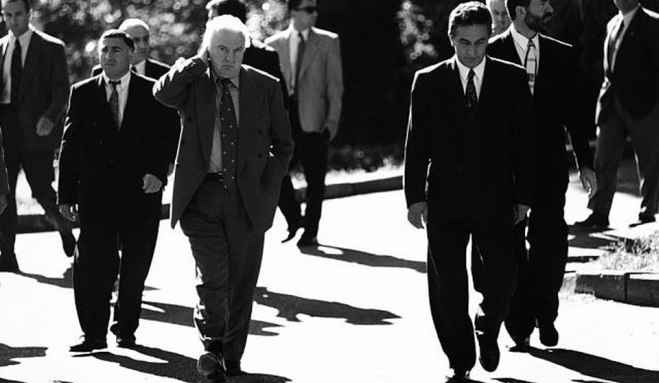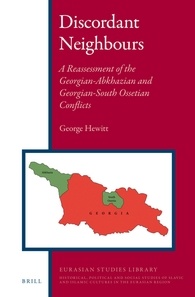Review of George Hewitt, 'Discordant Neighbours: A Reassessment of the Georgian-Abkhazian and Georgian-South-Ossetian Conflicts' by Rene Wadlow

Eduard Shevardnadze (left) and Vladislav Ardzinba in 1992
(Leiden: Brill, 2013, 389pp.)
The UN Human Rights Report 2004 offers a survey of methods used for state formation beyond killing and expulsion:
-
centralization of political power, eliminating local autonomy;
-
construction of unified legal and judicial systems;
-
adoption of official language laws;
-
construction of nationalized systems of compulsory education;
-
diffusion of the dominant group's language and culture;
-
adoption of state symbols celebrating the dominant group;
-
seizure of land, forests and fisheries from minority groups;
-
adoption of settlement policies favoring the dominant group;
-
adoption of immigration policies favoring dominant groups.
Variations and combinations of all these techniques including killing and expulsion have been tried in the Caucasus both by Joseph Stalin who as Commissar of Nationalities was particularly interested in nationality policies and by his successors. George Hewitt, a linguist and historian, has focused on Georgia and its recent relations with Abkhazia and South Ossetia, but the shadows of violence and ethnic-based demands in Chechnya and Dagestan as well as the continuing conflict between Armenia and Azerbaijan over Nagorno-Karabakh are part of the same story. “The narrow isthmus separating the Black Sea from the Caspian Sea is famed not only for housing the mighty Caucasian mountain range...but also for being one of the most complex ethno-linguistic regions on earth. “
This has led to political policies, which, as one author wrote “All nations want to be ruled by people of their own kind, even if they are unkind and prefer their own to a kind majority of the other.”
While the roots of the Georgia-Abkhazia tensions go back to the Russian Revolution and the short-lived Menshevik Republics before being incorporated into the Soviet Union, it was in 1992, shortly after the independence of Georgia that Abkhazia drew world attention.
After the erratic rule of Zviad Gamsakurdia, the first president of Georgia after the breakup of the Soviet Union, Eduard Shevardnadze had become president. He was well known at the United Nations for his efforts as Minister of Foreign Affairs of Mikhail Gorbachev. On 14 August 1992, Georgian troops moved into Sukhum, the capital of Abkhazia, which had had different degrees of autonomy within Georgia depending on the period and overall Soviet policy.
Different reasons have been advanced as to why Shevardnadze (or his circle) took what he knew was a risky move to quash Abkhazia's autonomy once and for all through military means when negotiations on the status of Abkhazia were going on. Most Abkhazian authorities left Sukhum to organize a resistance movement, helped by neighbors such as the Chechen who were part of the Confederation of Mountain People of the Caucasus.
Despite some ceasefires and efforts of UN mediation led by the Swiss Ambassador Eduard Brunner, fighting lasted for over a year until the end of September 1993. During this time a good number of people fled or were pushed out of Abkhazia . Refugees and their possible return or compensation have been an issue between Georgia and the independent government of Abkhazia. The fighting led to a rapid economic decline of Georgia. There was little Abkhazian economy to decline.
Had there not been armed violence, there might have been other possibilities for association than the current status of two independent States on bad terms. There had been proposed a number of federal or con-federal forms of association, but the possibilities were swept away by violence.
The same pattern was largely followed in Georgian-South Ossetian relations. At the start, the demands of the South Ossetians were more to be united with North Ossetia, part of the Russian Federation. However, again in August but of 2008, the president of Georgia, then the young and dynamic Mikheil Saakashvili decided to put an end to the troubled status of South Ossetia by sending in troops. However, the Russian troops stationed in nearby North Ossetia quickly intervened.
Again, South Ossetia is now an independent country on bad terms with Georgia. Both Abkhazia and South Ossetia are recognized by few major States beyond the Russian Federation, but independence of both countries came in ways that will prevent for political and psychological reasons any form of federation or integration with Georgia. As Hewitt notes “Had the Georgian leadership proposed restructuring along federal lines, with meaningful power devolved to the regions (especially those where the main minorities resided) as Georgia moved from Soviet republic to independence, the transition might have been achieved harmoniously, as even the Abkhazians seemed ready for such a relationship.”
Creating new types of political association takes time, goodwill and a willingness to compromise, to do with “less than the best”. Unfortunately, the years of Soviet rule did not create these traits in the leadership of the republics now become independent, nor within the ethnic-based regions within the new republics as we see currently in Ukraine. Hewitt's book is a solid, detailed analysis of the events and will be essential reading for those who follow the Caucasus and federal structures.
Rene Wadlow is the President of the Association of World Citizens, an international peace organization with consultative status with ECOSOC, the United Nations organ facilitating international cooperation on and problem-solving in economic and social issues.
 Discordant Neighbours: A Reassessment of the Georgian-Abkhazian and Georgian-South-Ossetian Conflicts
Discordant Neighbours: A Reassessment of the Georgian-Abkhazian and Georgian-South-Ossetian Conflicts